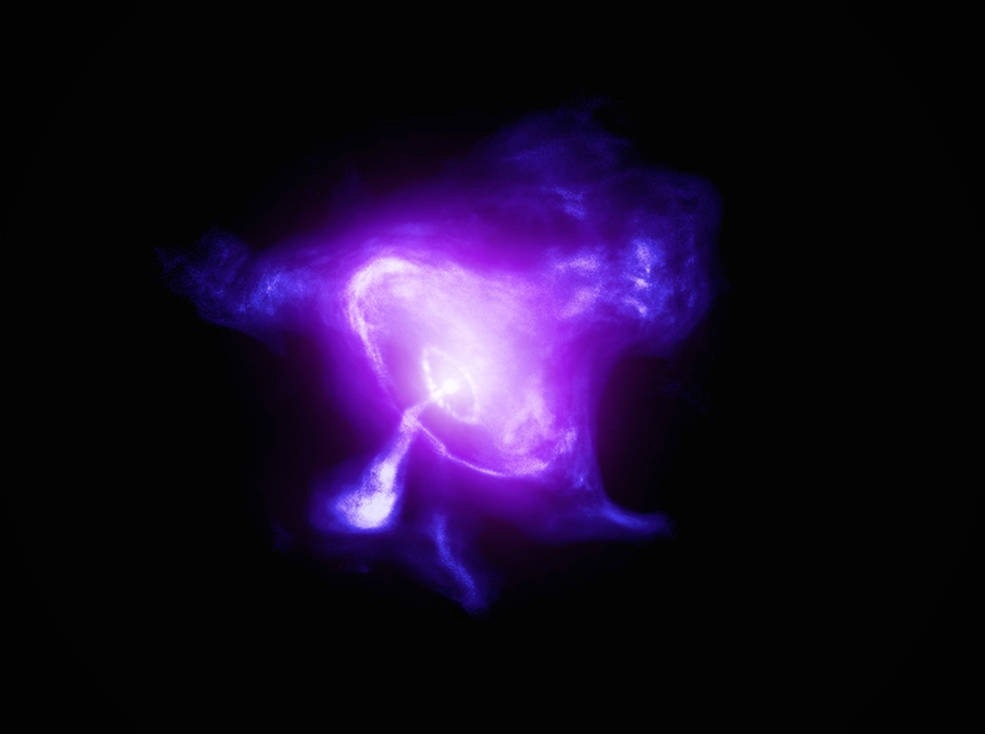At Wallops Island, Virginia, a sounding rocket lifted off on February 22nd, 1971. This rocket went into space with specialized sensors intended for the Crab Nebula, a bright cosmic object that is around 6,500 light-years away.

This image of the Crab Nebula combines data from NASA’s Imaging X-ray Polarimetry Explorer (IXPE) in magenta and NASA’s Chandra X-ray Observatory in dark purple. Image Credit: X-ray (IXPE: NASA), (Chandra: NASA/CXC/SAO) Image processing: NASA/CXC/SAO/K. Arcand & L. Frattare
In the past, before retrieving physical tapes from the experiment, scientists initially obtained scientific data on a strip chart recorder, which is a device that printed signals on paper. Astronomer Martin Weisskopf, together with his collaborators, started the analysis on launch day by quantifying the distance between signals with the help of a ruler and pencil.
What makes science so beautiful and exciting is that for those few moments, you’re seeing something that no one has ever seen before.
Martin Weisskopf, Emeritus Astronomer, Marshall Space Flight Center, National Aeronautics and Space Administration
After many years, Weisskopf suggested the development of an Earth-orbiting satellite with strong instruments that have the potential to collect much more elaborate measurements of the same kind regarding the Crab Nebula and other puzzling cosmic objects. That satellite turned out to be NASA’s Imaging X-Ray Polarimetry Explorer (IXPE), which was launched on December 9th, 2021.
Now, over five decades after the sounding rocket experiment, researchers have made use of IXPE to make an elaborate and subtle map of the Crab Nebula’s magnetic field. This helps uncover more of its inner workings than ever before.
The new outcomes, reported in the journal Nature Astronomy, help solve longstanding puzzles regarding the well-studied Crab Nebula and set the stage for new questions for future study.
IXPE data display that the magnetic field of the Crab Nebula matches that of the Vela Pulsar Wind Nebula, which is also in the shape of a donut. However, at the Crab, researchers were surprised that areas of magnetic field turbulence were more patchy and asymmetrical compared to what was anticipated.
This is a clear indication that even the more complex models developed in the past, with the use of advanced numerical techniques, do not fully capture the complexity of this object.
Niccolò Bucciantini, Study Lead Author and Astronomer, INAF Arcetri Observatory
A popular object of study among astronomers, the Crab Nebula led to a supernova documented in the year 1054. The explosion caused omitted dense object known as the Crab Pulsar, around the diameter of Huntsville, Alabama, or the length of Manhattan, but with as much mass as around two Suns.
The chaotic mess of shock waves, gases, magnetic fields, and high-energy light and particles of the rotating pulsar is jointly known as a so-called “pulsar wind nebula.” Such extreme conditions make for a bizarre area that is yet to be understood completely.
By quantifying the polarization of X-Rays from the Crab Nebula, Weisskopf and collaborators were hoping to understand this extreme environment with a new approach.
X-Ray polarization provides researchers with clues as to the direction where the magnetic field points in various parts of a cosmic object and also how well-ordered the magnetic field is. The geometry and turbulence of the magnetic field identify how particles are catapulted at the speed of light.
In just the five minutes that the 1971 sounding rocket experiment spent over Earth’s atmosphere, it produced the first X-Ray polarization measurements of the Earth.
Researchers monitored this with a satellite known as OSO-8 in 1975, which also quantified the X-Ray polarization of the Crab Nebula. Normally, the rocket and the satellite produced the same outcome: the Crab Nebula consists of an average polarization of nearly 20%.
As a project scientist at NASA’s Chandra X-Ray Observatory, which launched in 1999, Weisskopf continued his examination of the Crab Nebula with new methods.
With Chandra, “we took beautiful images of the nebula and pulsar, and we could see the jets and the various structures.”
Chandra’s X-Ray imaging disclosed wisp-like structures that tend to move in the nebula and assisted researchers to additionally comprehend the relationship between the energy and X-Ray emissions of the pulsar.
To gain better insights into this puzzling supernova remnant, almost every recent large telescope has denoted the Crab Nebula. However, only IXPE could study X-Rays from Crab concerning polarization, a measure of the organization of electromagnetic fields.
The Crab is one of the most-studied high-energy astrophysical objects in the sky. So it is extremely exciting that we could learn something new about this system by looking through IXPE's ‘polarized lenses’.
Michela Negro, Study Co-Author and Research Scientist, Goddard Space Flight Center, National Aeronautics and Space Administration
Negro is affiliated with the University of Maryland, Baltimore.
Throughout the complete nebula, IXPE discovered nearly the same average polarization as Weisskopf and collaborators did in the 1970s. However, with the availability of highly advanced instruments, IXPE was capable of refining the angle of polarization and analyzing the variations in polarization throughout the entire object.
Researchers look for areas of much polarization in the nebula’s outer regions, light-years away from the pulsar, where polarization is in a lower state.
This allowed researchers to examine not just X-Rays from the Crab Nebula but also those coming from the pulsar itself, or the sphere of magnetic fields present around it. The findings indicate that those X-Rays come from the outer magnetic field region, known as the “wind” region, although precisely where and how is yet to be discovered.
Inside the magnetic field, shocks produced by the pulsar’s “wind” are known as propelling particles that are close to the speed of light.
“I'm very proud of everybody associated with IXPE,” stated Weisskopf, who was the first principal investigator of the mission. “Everybody has worked so hard, and it works as advertised.” Having reflected on his work on the 1971 experiment that laid the groundwork for the new outcomes, Weisskopf stated, “It’s like somebody said to me, ‘Martin, you did good.”